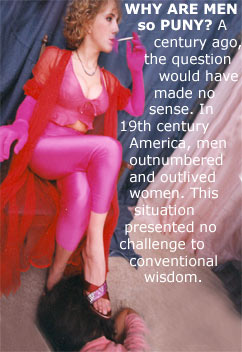 |
 |
 |
| |
|
|
|
|
|
NATURAL SUPERIORITY OF WOMEN PART 2
Many
thanks to In Health Magazine &
Additional
research was also provided by |
 |
Kassandra
(1990) © 2004 Rasa Von Werder |
Throughout
the modern world, cultures are different, diets are different, ways of
life and causes of death are different, but one thing is the same - women
outlive men. |
It starts even before birth. At conception, male fetuses actually outnumber females by about 115 to 100; at birth, the ratio has already fallen to about 105 boys to every 100 girls. By about age 30, there are only enough men left to match the number of women. And from there on, women start building a lead that just grows and grows. Beyond age 80, there are twice as many women as men. "What's dramatic," says Deborah Wingard, an epidemiologist at the University of California at San Diego, "is that if you look at the top ten or twelve-causes of death, every single one kills more men." She runs a finger down this melancholy Top Ten and rattles off one affliction after another; heart disease, lung cancer, homicide, cirrhosis of the liver, and pneumonia. Each kills men at roughly twice the rate it does women. "Diabetes," Wingard resumes after catching her breath, "is the only one that even comes close to being"-she pauses, in search of a nonjudgmental word-"to being equitable." Women's superiority extends far beyond merely living longer. Women are better than men at distinguishing colors. They have a sharper sense of taste and a better sense of smell. Would any child, confronted with a dubious-looking glass of milk, be so foolish as to give it to his father, rather than his mother, to sample? The differences between men's and women's sexual capacities are much too familiar to need repeating here. Mark Twain once devoted a bitter essay to satirizing the workmanship of a Creator who had come up with two such mismatched creatures. "After fifty, [a man's] performance is of poor quality, the intervals between are wide, and it's satisfactions is of no great value to either party," Twain lamented in his old age. "Whereas his great-grandmother is as good as new."
Helen Klein, a 68-year-old who considers a 50-mile race routine, holds all the "ultramarathon" records in her age group. Women win so many long-distance dogsled races that one musher has designed a "Save the Males" T-shirt. In real-life ordeals, too, women seem at least as durable as men. One man trapped in the Warsaw Ghetto by the Nazis kept a journal in which he recorded the growing misery of his fellow Jews. "At 14 Ostrowska Street is a house where there are only women and children," he wrote in the cold and hungry winter of 1942. "All the menfolk have died. In general, men have a markedly higher mortality- the reason being that men have less endurance, work harder, and so forth." Six miserable months later, the diarist continued to marvel at "the courage and endurance of our women" who were now "coming forward to replace the men, who fall out exhausted." In bad times, women may also be psychologically more resilient than men. A study of areas of London heavily bombed during World War II, for example, found that 70 percent more men than women became psychiatric casualties. The study's (male) author summarized its findings: "It may be true that women are more emotional than men in romance, but they are less so in air raids." Women have more acute hearing than men, and keep their hearing longer. Women have colder hands and feet than men, but complain and suffer less when exposed to bitter cold. Are you beginning to detect a pattern? Men out-stutter women four to one. Men go bald, and sprout hair from their ears to make up for it. They're more likely to be color-blind, 16 to one, and are especially prey to ulcers and hernias and back problems. Faced with such a list of defects, any conscientious manufacturer would have issued a product recall.

Mimi
Chantal & James (1992)
© 2004 Rasa Von Werder
In
outdoor atheletics, women aren't a match for men. But one trend is worth
noting: the more a competition requires stamina, the better women fare.
The first woman to win a mixed-sex national championship did so in a 24-hour
endurance race. Ann Trason ran 143 miles worth of circles around a track,
four miles more than the (male) runner-up. |
 |
Autumn
Equinox & James (1994) © 2004 Rasa Von Werder |
Women were, authorities from the Bible to Shakespeare agreed, "the weaker vessel." God was in His heaven, all was right with the world. But in the 20th century, the trend reversed itself. Women began living longer than men, primarily because pregnancy and childbirth had become less dangerous. The gap grew steadily through the decades. In 1950, for the first time ever in the United States, females outnumbered males. That made for some wrinkled brows. If men were so strong, why were they all dying? Part of the damage turned out to be self-inflicted. Overall, statisticians figure that one-third of the longevity gap can be attributed to the ways men act. Men smoke more than women, drink more, and take more life-threatening chances. Men are murdered (usually by other men) three times as often as women are. Overall, they commit suicide at a rate two to three times higher than that of women. This fact holds for every age group, without exception, whether you compare teenagers or the middle-aged or the elderly. If men don't have guns or knives, they make do with cars. Men have twice as many fatal accidents per mile driven as women do. Men are more likely to drive through an intersection when the light is yellow or red, less likely to signal a turn, more likely to drive after drinking. Men drivers!
But behavior doesn't explain away the longevity gap. Women seem to have an innate health advantage. Even among people who have never smoked regularly, for example, the death rates from heart disease, lung cancer, and emphysema are between two and four times higher for men than women.
Breadwinning in earlier eras may have had more panache—slaying a lion with a spear called for a certain flair—but earning a living in the modern workplace was portrayed as just as dangerous. A popular book called “Stress and Your Heart”, published in 1961, summed it all up: "It seems that being the breadwinner—whether man or woman— is a difficult job. Tension is inevitable. The job of homemaker, on the other hand, gives the woman some time—if she desires it—to relax and let some things go."

Klementine
(1990)
© 2004 Rasa Von Werder
As
the fifties drew to an end, conventional wisdom finally came up with an
explanation. Men's problem wasn't biology so much as newly discovered
killer called stress. Heart disease was claiming more and more male victims,
and the reason, according to the new way of thinking, was that stress
lurked in office buildings and corporate boardrooms, the very places men
spent their days. |
Let women be so foolish as to venture out of the home and into the line of fire, the good doctors thundered, and they would begin dying at the same-rate as men. But a funny thing happened on the way to the funeral.
Between 1950 and 1985, the percentage of employed women in the United States nearly doubled. Those working women, study after study has found, are as healthy as women at home. And where differences between the two groups have been reported, the advantage has gone to the working women.
The reason, it seems, is that paid work provides women with feelings of self-esteem, responsibility, and camaraderie that outweigh its drawbacks. Work is no picnic—that's why they call it work-but it appears to beat staying home.
Scientists who have studied the female-male health gap find that all the data point to one conclusion: Mother Nature is a bigot. "In comparison with the female," according to one zealous researcher, "there can be little doubt that the male has a higher mortality rate in almost all forms of animal life studied thus far, in nematodes, mollusks, crustaceans, insects, arachnids, birds, reptiles, fish, and mammals." Whether you're a man or a mouse, a fruit fly or an alligator or a pheasant, females live longer. Not that studying mortality tables for spiders will shed much light on the human gender gap.
The doomsayers had predicted that employed women would collapse under the stress of "role overload" as they tried to juggle work, children, and home-making. The extra stress is there, surveys confirm, but it hasn't brought ill health along with it. |
Every living thing is assembled according to in¬structions on its chromosomes, though, and con¬siderable work has been done on the ways male and female chromosomes differ. Humans have 23 pairs of chromosomes. Males have one nonmatching pair, denoted XY, while the corresponding pair in females is xx. This xx pairing is often cited as the-secret of women's superiority.
The reasoning is straightforward: The two chro¬mosomes of a matching pair are nearly but not quite identical, like two neighbors' recipes for the same dish. Even if there is a mistake in one chromosome's recipe (if egg whites aren't listed among the ingredients for chocolate soufflé) dessert may still turn out fine, because the other chromosome has its own recipe.
But males have only a single X chromosome-one recipe—and so they are more
vulnerable than females to any errors on it. If their one recipe omits egg whites,
the souffle is going to be a flop. If their single x chromosome is defective,
it's possible for a serious genetic disorder to appear.
That makes for a whole list of genetically determined and predominantly male foul-ups. These can be innocuous, like color-blindness or the inability to ask for directions even when hopelessly lost. But they can also be devastating. Hemophilia and muscular dystrophy, for instance, are diseases caused by a defect in a single gene on the X chromosome. They are far more common in males than females.
The chromosome theory has problems, though. For one thing, in birds, butterflies,
and moths, it is males who have the double chromosome and they still die before
females. More importantly, there just aren't enough cases of the most feared
genetic diseases to account for more than a tiny bit of the longevity gap between
men and women. A University of Pennsylvania study said: "Most of the common
x-linked diseases aren't fatal, and most of the fatal x-linked diseases aren't
common."
Diviana
& Ivan (1994) |
Twenty-two percent of women like the way they look nude, while 68 percent of naked men are pleased with their appearance. Thirty-eight percent of women work out expressly to lose weight, though only 20 percent of men pump iron to lighten up. . Men purchase 61 percent of all snack foods and consume about twice as many non-diet soft drinks as do women. Thirty percent of women and 21 percent of men drink skim milk. |
Even so, there still are researchers who believe chromosomes are the culprits. Some pin the blame directly on the x chromosome, the male chromosome. At a 1987 conference on aging, for example, John Hopkins's Kirby Smith reported on four generations of an Amish family he has been studying. The men appear absolutely normal, but they are missing part of their Y chromosome. For unknown reasons, these men not only outlive their male neighbors but also live several years longer than Amish women. With a flair for tabloid prose too rarely seen in science, Smith summarized his finding as "Too much Y and you die."
Most scientists think the answer lies elsewhere. They focus on hormones, and
though the hormone theory doesn't account for all of women's advantages over
men, it goes a long way toward explaining a crucial one. For both sexes, heart
disease is the leading cause of death. The difference is that women have an
extra decade of immunity before they start to succumb.
Estrogen (from the Greek for "producing frenzy"!) seems to be the key. Before age 40, when virtually all women are still producing estrogen, heart disease kills three men for every woman. But from that point onward, the odds in favor of women drop steadily.
To buttress the argument, instead of comparing men and women of the same age,
compare pre-menopausal and postmenopausal women of the same age. Again, the
women whose ovaries are producing estrogen are the ones with the healthy hearts.
Moreover, postmenopausal women who take estrogen supplements seem to have less
heart disease than matching groups.
And just as estrogen seems to be the heroine of the story, testosterone, the male sex hormone, seems to be the villain. Until puberty, boys and girls have the same cholesterol levels. But when boys hit adolescence and testosterone kicks in, their level of HDL cholesterol, "good cholesterol," plunges. In girls, HDL levels hold steady. Women maintain that advantage throughout their lives.
 |
Klementine
(1990) © 2004 Rasa Von Werder |
And just as estrogen seems to be the heroine of the story, testosterone, the male sex hormone, seems to be the villain. Until puberty, boys and girls have the same cholesterol levels. But when boys hit adolescence and testosterone kicks in, their level of HDL cholesterol, "good cholesterol," plunges. In girls, HDL levels hold steady. Women maintain that advantage throughout their lives.
The story of LDL cholesterol, "bad cholesterol," is similar. In both
sexes, HDL levels start a steady rise at puberty. But the increase is steeper,
and therefore more dangerous, in men. When menopause begins (and estrogen production
plummets), women's LDL levels climb higher than men's. This raises the risks
for women, but their high HDL, levels still leave them better protected than
men are.
One moral seems to be that testosterone has hung on past its glory days. The
hormone, which seems to cause aggressiveness and which certainly produces big
muscles, may have been a nifty inno¬vation when man's major duty was hurling
rocks at the next tribe. Back then, a 30-year-old ranked as a tribal elder.
Today we live decades past our reproductive prime. We hunt only if someone has
misplaced the remote control clicker. We tend to go light on the nuts and berries
and heavy on the cheeseburgers and chill dogs. Testosterone doesn't seem like
such a bargain anymore.
Testing the testosterone-as-bad-guy theory is tricky, because recruiting volunteers
is so tough. Veterinarians have provided one clue. Neutered tomcats, it turns
out, live about two years longer than their intact brothers. Part of the reason
is that they are less likely to die in fights, but even if you look only at
cats that died of natural causes, the neutered cats lived longer. Spaying females
doesn't affect their lifespans.
The obvious place to look for more evidence is at accounts of the thousands of eunuchs who served through the centuries as palace guards in Europe and Asia. As late as 1896, the Emperor of China employed 3,000 eunuchs, and the Ottoman Empire, which lasted until 1923, never abandoned the practice. At the centers of European culture, castrati were operatic superstars, whose unearthly singing inspired cries of "Viva il coltello!" ("Long live the knife!"). But no one ever studied the longevity of these men.
For that, we have to turn not to ancient Rome or imperial China, but to Kansas only a few decades ago. There and elsewhere, mental hospitals and homes for the retarded sometimes castrated their inmates, usually with the intent of rendering them more docile. One research team studied 297 men who had been castrated at an institution for the mentally retarded in Kansas. The last operations were performed in 1950.
 |
 |
Kassandra
(1990)
© 2004 Rasa Von Werder
Except for having had the bad luck to fall into the surgeons' hands, the researchers
claimed, the eunuchs were strictly comparable to the other men in the study.
But on the average, the castrated men outlived a matching group of male inmates
by nearly 14 years. Even more surprising, they also outlived a peer group of
female inmates. "It is probably impossible to devise any [other] way to
select a group of males that would outlive females," the authors observed.
NOT EVERY DIFFERENCE between the sexes favors women. On average, men are taller
than women and have heavier bones and bigger muscles. Men will die sooner, but
we'll have hit more home runs by the time we go.
Men have sharper eyes and quicker reaction times. And psychologists who spend
their days tormenting volunteers claim that men have a higher threshold of pain.
This will come as a surprise to any father who has fainted in a delivery room.
Men are leaner, with about 10 percent less body fat than women. The reason presumably
lies in our evolutionary history—women's bodies are designed so that,
even in hard times, there will be an easy-to-tap fuel reserve for pregnancy
and nursing. Estrogen lends a hand by helping the body convert food to fat.
(When unscrupulous chicken growers wanted plump, tender birds in a hurry, they
added estrogen to the feed. Testosterone would have made for tough, stringy
birds, with a tendency to get in bar brawls.)
It's a good system if there's a risk of famine. In ordinary circumstances, though,
the effect is that men have an easier time than women losing weight. Holding
to a steady weight is easier, too, because men are bigger and our metabolism
is about 6 percent faster. We gulp in more oxygen and throw off more heat.
As a result, men have the luxury of burning twice as many calories as women
do. Men stay thin be¬cause we're gas guzzlers; we're puffed with pride because
we hardly get any miles to the gallon.
That headstart in fighting paunch favors men, but it has more to do with vanity than health. Men do have one undisputed advantage over women that is far more than cosmetic. Autoimmune diseases, illnesses in which the immune system attacks the body rather than protects it, strike women disproportionately. Multiple sclerosis, for example, affects twice as many women as men. For lupus, a sometimes fatal disease in which the immune system can disable any of the body's organs, the ratio is nine women to one man. For rheumatoid arthritis, three to one.
Even here, there is speculation that the problem is too much of a good thing.
Some scientists believe that females have more robust immune systems than males
do. That would make for a better defense against illness, usually, but it might
also increase the odds that the immune system would turn traitor, by shifting
into overdrive or going haywire.
The case is hardly airtight. It's true that pre-natally and in infancy, boys
are more vulnerable to fatal infections than girls are. But, later on, there's
no evidence that women are better than men at fighting off disease. Overall,
cancer's death toll, for example, is roughly equal in both sexes.
Day in and day out, in fact, women feel sicker than men do. Women make more
visits to the doctor, take more prescription and nonprescription drugs, and
spend more days stuck in bed. This is not a new phenomenon. In 1676 one diarist
noted in passing, "I have heard physicians say that they have two women
patients to one man."
Since women nonetheless manage to outlive men, this has made for a nasty but
entertaining debate among medical scholars. One faction contends, essentially,
that women feel sick so often because they are "in touch with their bodies."
Men, on the other hand, are too brutish or too proud to notice they're not feeling
well. This is reminiscent of a story I was told when I was little, about how
dinosaurs were so dumb that they walked around for a week after they had died,
because it took that long for the message to make its way to their brains.
The contrary view is just as unflattering, though it slanders women. This position
can be summed up as follows: Do women complain more, or what?
But the resolution of the great "Who's sicker?" debate seems easy
enough. Women turn out to be less vulnerable than men to life-threatening diseases,
but more vulnerable to everyday sicknesses and pains. Women are plagued by arthritis
and bunions and bladder infections and corns and cal¬luses and constipation
and hemorrhoids and menstrual woes and migraine headaches and sleepless nights
and varicose veins.
In the meantime, men get heart attacks and strokes. Women are sick, but men
are dead.

Autumn
Equinox
& James (1994)
© 2004 Rasa Von Werder
Women buy 40 percent of all condoms. Forty percent of women and 16 percent of men regret having had premarital sex. Thirty-six percent more women than men read books regularly. A woman's brain is larger in proportion to her body weight. There are 58 percent more men in mental institutions and treatment centers. There are six power ties for every five pairs of pumps in the work force. A man will take home 12 percent more salary than a woman in the first year after both receive an M.B.A. Female physicians see 36 percent fewer patients per hour; men visit physicians 37 percent less than do women. Ten percent of school-age boys are diagnosed dyslexic, compared with about 3 percent of girls. |
When it comes to mental health, more or less the same picture holds. Women are more likely than men to be miserable day to day, but men are more likely to have devastating illnesses. Women bend and men break.
Depression, for example, is about twice as com¬mon in women as in men. But
schizophrenia, the most debilitating mental illness, is twice as common in men.
And (in part because of schizophrenia) men in mental hospitals outnumber women
three to two.
After a spouse dies, men fare far worse than women. They are more depressed,
more likely to seek psychiatric help and to need tranquilizers, and more likely
to fall ill. In the first months that they are alone, according to several studies
a few years back, men are more likely than women to follow their partners into
the grave.
Some social scientists skeptical of this work refused to believe that the men
were dying of grief. They proposed, instead, that the widowers' problem was
malnutrition, because they didn't know how to cook. More recent studies have
settled the question—the men died so soon after their wives that grief
had to be the cause; they hadn't had time to starve.
Men fare poorly, it seems, because in many cases their wives were their sole
confidantes. Without spouses to share problems and fears, newly widowed men
are left alone to founder and sink. Women who lose their husbands, in contrast,
often have a circle of close friends to confide in and count on.
The conventional explanation for differences in male and female psychology is
by way of analogy. Women respond to every dip and bump in the road, like cars
with springy suspensions. Men, who are trained to keep stiff upper lips, roar
over minor divots like cars with rigid shock absorbers. On good roads men do
well, but when they come to speed bumps or potholes, watch out.
But behavior changes. As a result, the health gap between men and women isn't
a fixed feature of the landscape, like the Grand Canyon. In recent decades,
the gap between men and women's lifespans has narrowed. It reached its maximum
of 7.8 years in 1970 and is now seven years. The explanation is not that women's
health is deteriorating. Women's health is improving, but men's is improving
faster.
Men, or some of them, are smoking less than they used to, drinking less, and
eating better. Gloomy forecasts about how women would start dropping like flies
as they moved into the workplace got things exactly backward. "The gap
isn't shrinking because women are acting like men," says Wingard, the University
of California epidemiologist. "It's shrinking," she goes on, with
barely concealed mirth, "because men are behaving more like women."
All images on this page © 2004 Rasa VonWerder
| HOME
| UPDATES
| GALLERIES
| FOUNDER
| SHOP
| INTERACT
| JOIN
US! © 2004 - 2006 RASA VON WERDER
|